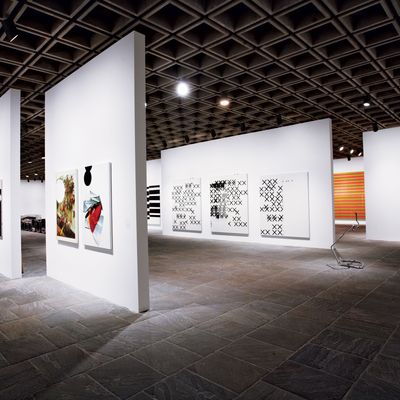
In the early sixties, Andy Warhol invented a new paintbrush. It was ┬¡Gerard Malanga, the assistant who applied and pulled pigments over WarholÔÇÖs early silk-screens. Andy, who would mutter things like ÔÇ£Oh, gee, thatÔÇÖs nice, GerardÔÇØ as he watched the young dreamboat work, was willing to be played for the fool, to be called ÔÇ£swishÔÇØ and ÔÇ£faggotÔÇØ by outsiders and forgo the accumulated masculine-historical authority of oil paint on canvas applied by hand, giving up all conventional ideas about touch in order to find another touch. The rest is art history.
In 2002, Wade Guyton invented a new paintbrush. Its name was the Epson printer. The rest isnÔÇÖt art history, butÔÇöas seen in the WhitneyÔÇÖs stylish, stately survey of GuytonÔÇÖs workÔÇöhis invention marks a step in paintingÔÇÖs evolution and flexibility. Employing Microsoft Word, desktop computers, Adobe Photoshop, bitmapped files, UltraChrome and DuraBrite inkjet on linen, book pages, exhibition invitations, and plywood, Guyton has arrived at something as powerful, albeit more subtle, yet as enticing as Dan FlavinÔÇÖs fluorescent lights. ItÔÇÖs a technique that implies the operation of almost unknowable forces. Instead of harnessing the pulsing color currents of FlavinÔÇÖs electricity, GuytonÔÇÖs flawed beauty and philosophical insight let us glimpse the ghost in the machine.
Decades after Flavin, and in the wake of recent artists whoÔÇÖve experimented with mechanical-reproduction techniquesÔÇölike Richard Prince, Rudolf Stingel, and Rosemarie Trockel, among many othersÔÇömaking formalist post-minimalistic paintings via machine is still a big bugaboo in some sectors. In a revealing video review of the show, the painter Loren Munk (under the pseudonym James Kalm) says many people are ÔÇ£fatootsedÔÇØ because Guyton creates with a printer; painters are ÔÇ£annoyedÔÇØ that Guyton is ÔÇ£trying to eliminate the hand.ÔÇØ These folks let ideology get in the way of the retinal payoff of this work, and itÔÇÖs too bad. GuytonÔÇÖs printer is adept at creating kinesthetic thickenings and intermingling overlaps, oscillations of pigment, gluts of color. He pushes the technology beyond its means, overloading it until the optic field fluctuates, and afterimages appear that reverberate with tensions that belie the apparent casualness of the process. ItÔÇÖs like seeing a mechanical aurora borealis. GuytonÔÇÖs is a sort of quantum touch: There and not there at the same time. It exists between the artistÔÇÖs computer screen and the way his printer handles its invisible transmission of pure information. I have no idea where the painting goes between his hitting SEND and its coming out of the printer. But the way the finished work looks is a record of what happened to this digital information as it passed through this cyber no-place. Which may be why Munk went from derisively cracking ÔÇ£I guess theyÔÇÖre calling them paintingsÔÇØ to, he says, ÔÇ£diggingÔÇØ the work.
You may too. ItÔÇÖs wonderful to see a youngish artist curated by a younger curator (Scott Rothkopf) and sense a new generation taking the museum stage. Good for the Whitney. The show is installed so that this complex esoteric subject can be grasped by the general public, and a zone of curiosity expands. (ThatÔÇÖs a feat in itself.) Space is open, and numerous works are visible at once, yet each maintains its seriousness. ThatÔÇÖs remarkable, considering how banal GuytonÔÇÖs sources are. We see flames taken from an old book cover; what look like faded Xerox copies; xÔÇÖs and uÔÇÖs, typed in a font called Blair ITC and fed to his printer; and stripe paintings (one of them blown up to 50 feet long) that derive, he says, from ÔÇ£an Italian design catalogue or something.ÔÇØ
Guyton has said he wanted to find ÔÇ£a space where objects could be speculative.ÔÇØ When I enter the exhibition, I feel the wonderful otherness of it. (I found myself coveting swaths of this show.) Yet as underdetermined, open, and speculative as GuytonÔÇÖs processes are, the ways he deploys them are fairly overdetermined. HeÔÇÖs talked about the difficulty of trying to make a mark ÔÇ£when you were overwhelmed by the history of art.ÔÇØ That disquiet shows, and is a weakness of his. Even though the work is made in unfamiliar ways, the final look of it is familiar, composed of elements from art history and modernist abstraction: motifs like stripes, dots, geometric abstraction, text, the monochrome, and standard collage. GuytonÔÇÖs references, mostly orthodox ones, parade before us like models on a runway: Duchamp, Judd, Kelly, Stella, Kippenberger, Levine, Prince. In evidence is a hypersensitivity to the critical theories of the seventies and eighties. ItÔÇÖs as if heÔÇÖs covering the classic rock of Modernism, Minimalism, and Post-Minimalism, reenacting the tried and true. It feels more imposed than discovered, less intellectually acrobatic than his processes.
This quasi-nostalgia gives GuytonÔÇÖs work a troubling, lurking aura, implying a ┬¡double-edged Romantic wish that art can again be what it once was. Rothkopf, in the catalogue, rightly talks about GuytonÔÇÖs ÔÇ£deep skepticism toward ÔǪ suspect notions of expression.ÔÇØ Except in the more chaotic team efforts heÔÇÖs explored with Kelley Walker, he doesnÔÇÖt get beyond that skepticism to embrace a big vision of what art can look like.
Still, Guyton has mastered a massive part of his art. HeÔÇÖs a natural at a Jasper JohnsÔÇôian hermeticism, physical sensuality, with a keen sense of bilateral symmetry, process, scale, and systematic art-making. Huge props. I love GuytonÔÇÖs brave new paintbrush, and his way of making paintings that reveal digital mysteries without being about ÔÇ£the digital.ÔÇØ I look forward to seeing him use his amazing bravery with less good art-historical taste.
Wade Guyton OS. Whitney Museum of American Art. Through January 13.
*This article originally appeared in the October 29, 2012 issue of New York Magazine.

